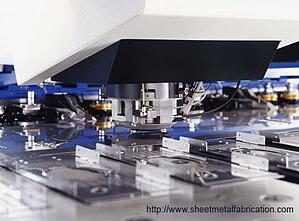
Sheet metal punching is one of the key techniques that Marlin Steel uses to shape custom metal forms for a variety of industries. With CNC metal punches, Marlin’s production team can create a variety of customized shapes out of varying thicknesses of sheet metal.
But, how does the sheet metal punching process work? Here’s a brief look at the process:
How Sheet Metal Punching Works
Modern metal punching is carried out by using heavy machinery, such as Marlin’s TruPunch 2020 machine, to create holes and indents in a piece of metal. The principle is relatively simple:
- The sheet metal being punched is sandwiched between the punch and a die.
- The punch moves downward and into the die. This causes the sheet metal underneath the punch to be sheared away from the surrounding material.
- Any cut metal is collected into a container for later use/recycling.
- Repeat steps 1-3 until the desired shape is achieved.
One specific process that is often used to achieve custom hole shapes is known as “nibbling.” In this process, a long series of very small holes are made, one at a time. These connected holes can create customized contours to fit specific needs. In a lot of cases, however, Marlin’s degreed engineers may use laser cutting instead of sheet metal punch processes to achieve these shapes because it places less physical stress on the workpiece.
What Affects Punch Quality?
The quality of each punch is determined by a few critical factors, including:
- The size/shape of the die and punch press
- The amount of force applied (the TruPunch 2020 applies up to 20 tons of force)
- The condition of the die and punch press (metal punch tools are only useful for so many “strokes” before becoming too worn to make clean punches)
- The thickness of the metal being punched (thicker metal is harder to punch neatly)
- The type of metal being punched (harder metals are more difficult to punch)
For example, when punching a round hole, it is generally recommended that the minimum diameter of the hole should be larger than the thickness of the metal. However, for especially sturdy metal alloys, the size of the hole may need to be even larger than that rule of thumb states.
Types of Metal Punchers
There are several different types of metal punching tools that accommodate different metal types and thicknesses.
Lever-Operated Hole Punches
These metal punchers come in different sizes: compact, portable, and bench-mount. They require manual force to be applied to the lever in order to create the desired punch. Due to their varying scale size, they can apply different punching forces.
Stud-Driven Hole Punches
This type uses studs and drill pilots to draw the workpiece onto the stud to create the punch. Depending on the desired hole diameter size, stud-driven hole punches can be performed with a wrench or hydraulic driver.
Hydraulic Hole Punches
Used for tough materials, these metal punches apply several tons of force to punch through workpieces such as railings, beams, and bars.
CNC Hole Punches
The preferred hole punch for steel, computer numerically controlled (CNC) punching machine moves a sheet of metal in an x and y direction to accurately position the sheet under the machine’s punching ram to punch a hole or form.
What about Shaping Sheet Metal?
There’s a separate process for indenting sheet metal that is sometimes carried out using the same equipment called sheet metal stamping. Whereas the punching process aims to punch a hole through sheet metal, stamping aims to deform the metal to create specific shapes–such as a vent opening or an indent.
The ability of a CNC punch to achieve this kind of shaping is a large part of the reason why sheet metal punching may be used in place of laser cutting for many custom metal forms. Since lasers do not use physical force, they cannot reliably shape metal in the same way that a CNC punch or press can.
Marlin Steel’s Sheet Metal Punching Solutions
Is sheet metal punching the right choice for your next custom metal basket or tray? Or, would you be better served with laser cutting? Before you make that choice, contact one of Marlin’s experienced mechanical engineers to discuss the particulars of your design and your manufacturing process!
We have years of experience in creating top-notch sheet metal forms for a variety of industries and specializations, and the tools to make the fullest use of said experience.



.gif)


